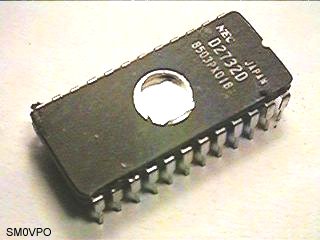

All has been quite this past month with little activity on the homepages, save for adding a few cosmetic buttons and organising the project lists into categories. The reason for this inactivity is that the EPROM projects have taken up so much of my time. EPROMs! So, what use are EPROMs in HamRadio? How can we use them? Why am I asking all these silly question? Read on and you will find out.

EPROMs can be used for a wide variety of purposes and NOT just for storing the BIOS in your PC computer. Here are a few practical examples that may be of benefit to you as a home constructor. The list is by no means comprehensive, but it does give you a good idea.
In this series of articles I will be showing you how to make your own EPROM programer and editor using your own PC. I will even include the software needed and include some binary listings for you to use yourself is certain applications. The minimum computer you will need is a 286 at 4MHz with 64K of free RAM after your operating system has been booted up. I will then take you on a small tour of generating sine and other waveforms, tone decoding as well as using a simple EPROM to replace a Programable Logic Array (PLA). These will all be included in a series of practical projects. Naturally, a Sine/Sawtooth/Triangle/Trapeze/Square/Other waveform generator will be one of the first projects. If you have never worked with EPROMs before then now is your big chance to start collecting them. You will find them in old computer games and even old obsolete computer circuit boards. Most electronic/radio companies have upgraded tools and so a lot of the older 2716 and 2732 EPROMS can be cadged (tiggade) for free.

EPROM is an acronym for Erasable Programmable Read-Only Memory. It is basicaly a device for holding a table of numbers. It has a little window in the centre of the chip so that the array of memory cells can be bathed in Ultra Violet light to discharge the charge held in each cell. The UV light wavelength should be around 255nM and a 4-watt tube will erase the whole chip in about 10 to 20 minutes or so. Ordinary sunlight will also erase the chips, but it will take a few months if you live in an area of dessert near the equator. In other climates it may take several years, so it is well worth investing in an EPROM eraser. When an EPROM is erased, every data bit in every cell will be set "1" so if you read a 4096 cell x 8bit then all 4K cells will contain 11111111 in Binary, 255 in Decimal or FFh in Hexadecimal.

The chip has a series of ADDRESS pins numbered A0, A1, A2, A3 ... etc. and it also has eight output wires, numbered from D0 to D7. Logic levels are between 0v t 0.8v for a logic "0" and 2.4v to 5.0v for a logic "1". It also has eight output wires, numbered from D0 to D7. To program you must:
The selected address may be reprogrammed ONLY if the bits you want to change are already "1" and you wish to either leave them alone or make them become "0".

Have fun and best regards from Harry
Return to INFO page